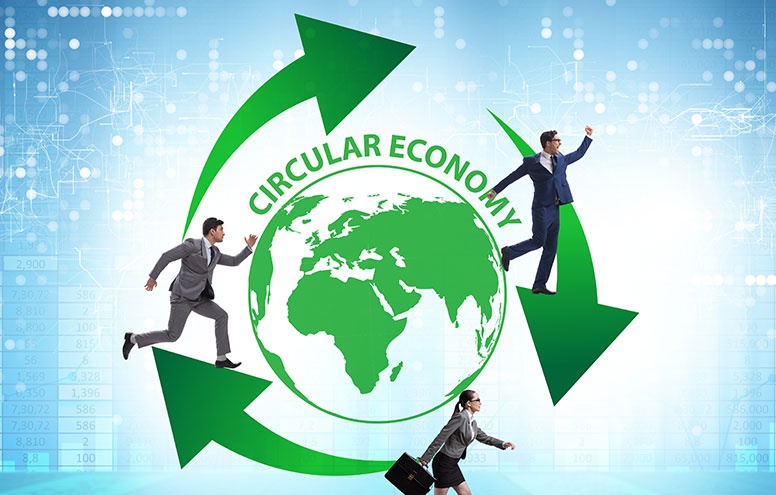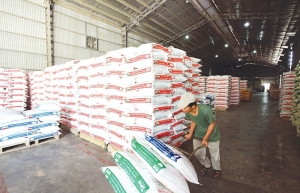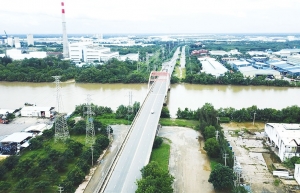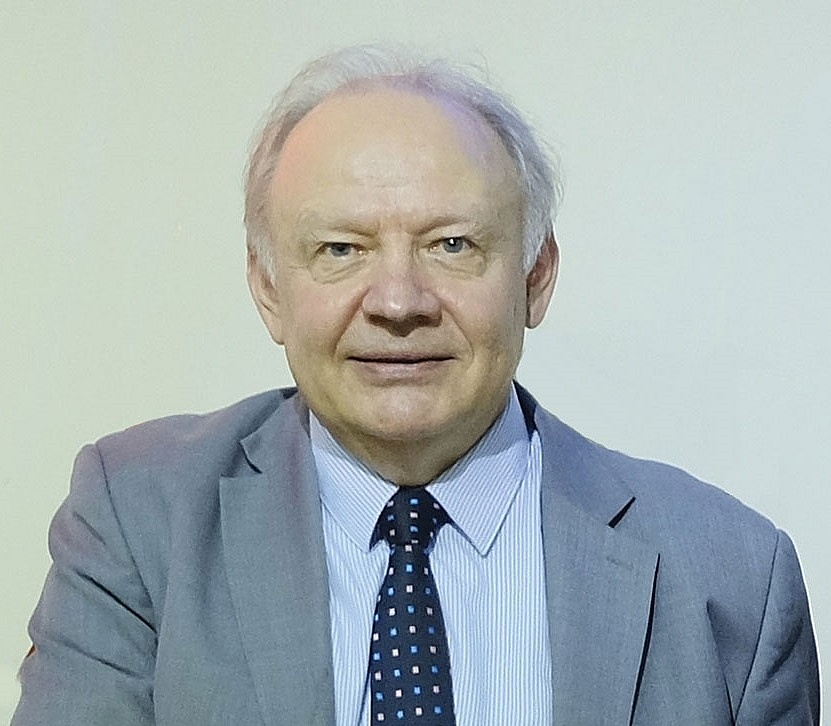Vast potential being wasted in co-processing of materials
Vicem But Son Cement JSC in the northern province of Ha Nam, a unit of Vietnam National Cement Corporation (VICEM), is still on the way to getting a license for carrying out waste co-processing after months of preparing procedures. According to a company source, it is still waiting for permission from the Ministry of Natural Resources and Environment (MoNRE) to go ahead with the move.
 |
| Vast potential being wasted in co-processing of materials |
Cement companies and experts said there is huge potential for groups like Vicem But Son to co-process waste and raw materials from various industries and sectors. However, the inevitable burdensome procedures and lack of supporting policies, as well as legal barriers related to volume limitation and transformation, are hindering progress.
Co-processing involves the use of suitable waste materials in manufacturing processes for the purpose of energy and/or resource recovery, and the resultant reduction in the use of conventional fuels and/or raw materials through substitution. In the case of most cement groups, co-processing refers to the use of a cement kiln to cleanly burn plastic waste as an alternative energy source while utilising the ash leftovers in the cement itself.
At a workshop last week hosted by the Norwegian Embassy in Vietnam and the Norwegian Foundation for Scientific and Industrial Research, government agencies, companies, and experts discussed the potential, challenges, and possible solutions surrounding the issue in Vietnam in particular.
Luong Duc Long, deputy president of the Vietnam National Cement Association (VNCA), said, “Co-processing of waste, sludge, and raw materials for alternative fuels is important for industries and sectors, including the cement industry, in Vietnam and worldwide to protect the environment and to bring benefits for the economy.”
According to Long, co-processing helps reduce storage and handling costs, reduce space for burial and disposal, take advantage of heat energy, and lower coal consumption. Co-processing also enables preheater temperatures of 1,150-1,200 degrees Celsius and material temperature in rotary kilns of about 1,450 degrees, meaning it completely eliminates dioxin, furan, and polychlorinated biphenyls. It also reduces CO2 emissions by utilising waste.
Decent prospects
Participants at the workshop agreed that the potential for co-processing is huge in the cement industry as it can co-process waste from various industries to develop alternative fuels thanks to its advantages such as high and stable temperature, long residence time, high alkaline reactants, 24/7 emission monitoring system, large capacity, and no ash or disposal. Targeted industries include municipal solid waste, industrial non-hazardous waste, industrial hazardous waste, and others.
According to the VNCA, Vietnam ranks fifth in the world in terms of cement production capability with 57 cement factories and 81 production lines. The country can produce more than 100 million tonnes of cement per year on average. Fuel consumption for cement production in Vietnam is very high at about 10 million tonnes of coal (with a calorific value of 6,000 kcal/kg) per year.
Long from the VNCA elaborated that in 2018, the amount of municipal solid waste generated in Vietnam was 25.5 million tonnes, projected to rise to 45.83 million tonnes in 2030. Meanwhile, the threshold of industrial hazardous waste was 880,000 tonnes in 2018 and is expected to reach 2.4 million tonnes in 2030.
The Vietnamese government requires the use of alternative fuels in cement production with specific targets in 2030 of 15 per cent and 2050 of 30 per cent. According to the VNCA, to achieve those goals, in terms of reuse and co-processing of waste in the industry, all production lines have to use industrial waste as an alternative material. In 2025 this will require a minimum of 20 per cent, and 30 per cent at the end of the decade.
“There are just some cement companies that use alternative fuels in clinker production. However, the rate of substitution calculated by country is very small, at about 1 per cent. Therefore, the potential in Vietnam is huge for co-processing of waste, including non-recyclable plastic, as an alternative fuel in the cement industry,” Long noted.
Cement companies and experts have acknowledged the regulation-based challenges. Although under the Law on Environmental Protection the state adopts policies to encourage waste co-processing, these policies have not yet benefited cement companies.
Moreover, current regulations for cement factories to carry out co-processing remain problematic and few can meet the requirements. At present, there are 117 licensed hazardous waste treatment facilities in the country and only three co-processing units in the cement industry. Holcim Hon Chong Cement Factory in the Mekong Delta province of Kien Giang has a capacity of about 230,000 tonnes of hazardous waste co-treatment per year; and Thanh Cong Group JSC, located in the northern province of Hai Duong, has a capacity of about 190,000 tonnes.
Dao Chi Thang, deputy manager of Technical and Production Management at Nghi Son Cement Corporation in the central province of Thanh Hoa, said his company has been struggling with co-processing activities. “We have the license to collect and treat waste within the province only. We cannot collect waste from other provinces, even though we have the capacity,” he told VIR.
Similarly, Do Xuan Thinh, a technical expert at VICEM, admitted the mechanism and policies related to co-processing are still problematic. A section of the Codes and Practices in National Technical Regulation on Co-processing of Hazardous Waste in Cement Kiln (QCVN41) governs the location of cement plants when co-processing hazardous wastes. This means that just some cement manufacturers in particular locations can participate in the practice. Worse still, in related decrees, there appear to be no stipulations related to granting costs for waste treatment in the cement production process.
“These factors create a huge barrier for participating in waste co-processing by cement manufacturers. Meanwhile, there are no clear promoting and supporting mechanisms and policies for entities participating in the handling and treatment of ash, slag, synthetic gypsum, wastes, sludge, and others,” said Thinh. “As a result, VICEM currently has to procure waste, ash, slag, and synthetics for processing and we face difficulty in accessing waste sources and reducing waste treatment inefficiencies,” he added.
Committed to change
Currently, QCVN41 still limits cement producers from co-processing waste in other industries. For example, the regulations note loading points for different types of hazardous wastes. They do not allow loading of waste containing halogens into the preheat or precalcification units; or loading of organic waste (both hazardous and common) into the preheater.
Moreover, the regulations include hazardous waste that is not co-treated in cement kilns such as infectious or mercury-containing wastes from the medical and veterinary industries; waste containing asbestos; electrical and electronic equipment that has not been classified or dismantled; explosive and radioactive waste; and other wastes of unknown composition or not yet identified or classified.
It also limits values for different types of hazardous waste when put into co-processing.
Co-processing of solid wastes, including plastics, in cement kilns is now an integral component in the spectrum of viable options that have been practised in many developed countries, including Norway.
Mette Møglestue, deputy head of Mission at the Norwegian Embassy in Hanoi, said, “Both Norway and Vietnam, as signatories of the Paris Agreement, are strongly committed to combating climate change and implementing our National Determined Contributions to reduce greenhouse gas emissions. This requires cross-sector involvement.”
Norwegian research findings about using non-recyclable plastic wastes as alternative fuels for cement kilns have been successfully demonstrated and could be scaled up in Vietnam, added Møglestue. “Through the OPTOCE Project funded by the Norwegian government and being implemented in five Asian countries including Vietnam, we hope that Norway can help Vietnam’s cement industry improve its capacity to treat non-recyclable plastic wastes, and contribute to implementing Vietnam’s net-zero carbon targets by 2050.”
The cement industry is now waiting for amendments to the prevailing rules to promote co-processing. Do Tien Doan from the Department of Waste Management under the MoNRE said that his agency is now working on such amendments, including in QCVN41, towards facilitating cement factories to do co-processing, but no official timetable is yet forthcoming.
“The revision of QCVN41 may include promulgating general waste co-treatment standards; utilising specific and uniform regulations for the exhaust gas treatment system in cement kilns; regulating the maximum ratio of waste feeds into co-processing compared to the input capacity or raw materials and fuel; and more specific requirements about quality control of input waste,” Doan added.
| Kjell Tormod Pettersen - Norwegian Ambassador to ASEAN
We are facing a serious environmental threat, with a rapid increase in plastic waste ending up in our oceans with devastating effects on not only the environment but people’s livelihoods through the destruction of marine life and effects on fisheries and other industries. Due to its size, large population, long coastlines, and diverse economic activities, ASEAN is a global hotspot for plastic pollution and at the centre of this challenge. Estimates vary as to the precise degree, but many of the large rivers in the region are contributing to this challenge. We know that much plastic pollution now ends up on the seabed and is not visible to us: what is visible is bad enough. If we fail, we know the consequences. Ocean catches will be inedible, and the livelihoods of millions of people will disappear. We need to understand where the plastic comes from to stop it. How can we implement long-lasting measures, monitor the changes and learn from successful action? These questions are the backbone of the ASEANO project. The project is part of the Norway ASEAN partnership, and we are proud to seek solutions to the plastic challenge in the region together. Plastic waste comes from all parts of society. Thus, the ASEANO project has focused on selected key sectors contributing to plastic pollution nationally and regionally. The plastic packaging industry and the plastic recycling industry are primary targets. If solutions are too complicated, they will not work. The critical factor is using less plastic and not disposing of trash in the rivers and the ocean. Easy to say, but hard to implement. Norway attaches great importance to the sustainability of our common environment and oceans, and it is a priority of our foreign policy. In March this year, at the UN Environment Assembly in Nairobi, world leaders agreed on a new international, binding agreement on reducing plastic pollution to be finalised by 2024, a historical moment and considered by many to be the most important decision on the environment since the Paris Agreement on Climate Change in 2015. The leaders in ASEAN are very aware of the region’s environmental challenges: the Bangkok Declaration on Combating Marine Debris, the Blue Economy Declaration, and other framework documents are a testimony to this. I know from my own experience serving in Asia for many years that there is no lack of competence. However, we must find workable solutions, and we must hurry up, all of us. I recently visited the very north of Norway, where even in those remote areas, the plastic pollution on the beaches was alarming. There is no alternative, and we must safeguard our ecosystems and reduce pollution in our food and value chains. I have confidence in the work led by the Center for Southeast Asian Studies and the Norwegian Institute for Water Research, carried out in close collaboration with several other partners in Indonesia, the Philippines, and here in Vietnam. |
 | Raw material price hikes discouraging feed producers High prices of feed ingredients have been having an effect on feed producers while customers do not want to bear additional costs. |
 | Waste criteria lacking for nation’s IPs Vietnam’s industrial parks are in the process of transitioning to more ecological models, but are struggling due to a lack of regulations on reusing treated waste and wastewater. |
What the stars mean:
★ Poor ★ ★ Promising ★★★ Good ★★★★ Very good ★★★★★ Exceptional
Related Contents
Latest News
More News
- Schaeffler reports strong early output from Dong Nai solar project (December 12, 2025 | 15:16)
- Forestry conference highlights biodiversity and sustainability goals (December 09, 2025 | 13:35)
- Home Credit honoured among top 10 sustainable companies in trade and services (December 09, 2025 | 12:18)
- SCG and seven member companies honoured in Top 100 Sustainable Businesses 2025 (December 08, 2025 | 09:00)
- Nestlé Vietnam pioneers sustainable development and promotes business connections (December 06, 2025 | 12:09)
- CSI 2025 highlights rise of Vietnam’s green champions (December 06, 2025 | 09:00)
- Acecook Vietnam named among top 100 sustainable businesses (December 06, 2025 | 08:00)
- Vietnam’s forest carbon credits draw global interest (December 05, 2025 | 17:41)
- Coro Energy to launch BESS Pilot in Vietnam (December 04, 2025 | 15:12)
- Vietnam strengthens energy storage pathway (December 04, 2025 | 15:05)


 Tag:
Tag:






















 Mobile Version
Mobile Version